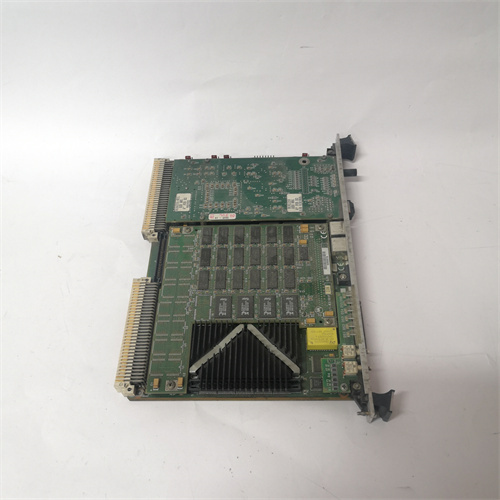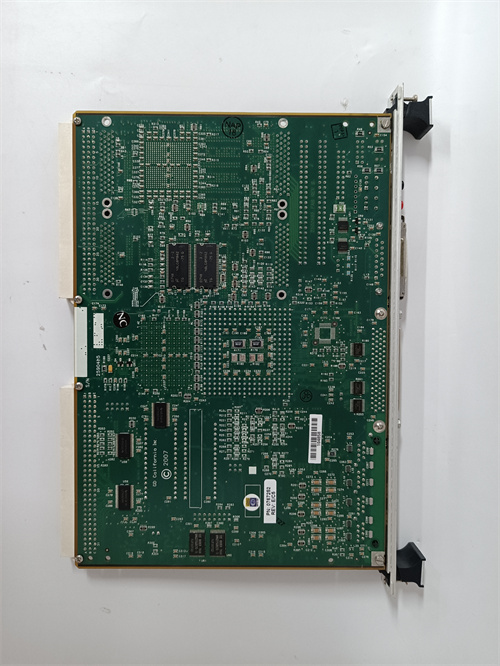Description
-1.jpg)
Parameter Specifications
- Processor and Memory
- The MVME7100 – 0171 is typically equipped with a high – performance PowerPC processor. It comes with a significant amount of onboard memory, including several gigabytes of DDR4 RAM for efficient data processing and storage. The flash memory capacity is also substantial, often several hundred megabytes, which can store the operating system, application software, and configuration data.
- I/O Interfaces
- It features a rich set of input/output interfaces. There are multiple Ethernet ports, supporting high – speed data communication at speeds up to 1 Gbps or even higher. Serial ports such as RS – 232 and RS – 485 are available for connecting to legacy devices or for specific communication requirements. Additionally, it may have PCI Express interfaces for expanding the system’s functionality with add – on cards.
- Power Supply
- The module operates on a standard industrial power supply voltage, usually in the range of 18 – 36V DC. The power consumption is optimized to ensure energy efficiency while providing stable performance.
Uses
- Industrial Automation
- In manufacturing plants, the MVME7100 – 0171 can be used as a central control unit for complex production lines. It can collect data from various sensors, such as temperature, pressure, and position sensors, and control the operation of actuators like motors, valves, and robotic arms to ensure smooth and efficient production processes.
- Transportation Systems
- For railway signaling systems or traffic control centers, it can process large amounts of real – time data from track sensors, traffic cameras, and other monitoring devices. Based on this data, it can make decisions and issue control commands to ensure the safety and efficiency of transportation networks.
- Energy Management
- In power generation and distribution systems, it can monitor electrical parameters, such as voltage, current, and power factor, from different substations and generators. It can also control the switching of electrical loads and the operation of power – regulating equipment to optimize energy consumption and distribution.
Weight and Dimensions
- Weight
- The MVME7100 – 0171 weighs approximately 2 – 3 kg, which is relatively light considering its high – end performance and functionality. This makes it easy to install and handle during system integration.
- Dimensions
- It has a compact form factor, with dimensions typically around 3U in height and following the standard VMEbus form factor. This allows it to be easily installed in standard racks, saving space in control rooms and equipment cabinets.
Characteristics
- High – Performance Computing
- Thanks to its powerful processor and ample memory, it can handle complex computational tasks and real – time data processing requirements, ensuring quick response times in critical applications.
- Scalability
- The module offers good scalability. With its PCI Express interfaces and modular design, additional functionality can be easily added by installing expansion cards, allowing the system to adapt to changing application needs.
- Versatile Communication
- The multiple communication interfaces enable seamless integration with a wide range of devices and systems, whether they are modern Ethernet – based devices or older serial – communication – based equipment.
Stability and Reliability
- Robust Design
- It is built with a robust mechanical structure and high – quality electronic components. This allows it to withstand harsh industrial environments, including high levels of vibration, shock, and temperature variations.
- Redundancy and Fault Tolerance
- The MVME7100 – 0171 may support redundant power supplies and communication paths. In case of a single – point failure, the system can continue to operate without significant disruption, ensuring high – availability in critical applications.
- Long – Term Testing
- The module has undergone extensive long – term testing under various operating conditions to ensure its stability and reliability over an extended service life.
Actual Cases
- Automotive Manufacturing
- In an automotive assembly plant, the MVME7100 – 0171 was used as the control brain for a robotic assembly line. It coordinated the movement of multiple robotic arms, ensuring precise assembly of vehicle components. By processing real – time sensor data, it could quickly adjust the operation of the robots to adapt to any production variations, improving the overall production quality and efficiency.
- Power Grid Monitoring
- At a regional power grid control center, the MVME7100 – 0171 was deployed to monitor and control the power distribution network. It continuously collected data from numerous substations, analyzed the electrical parameters, and made real – time decisions on load balancing and fault isolation. This helped to maintain the stability and reliability of the power supply in the region.
-1.jpg)


-1-200x200.jpg)
-1-200x200.jpg)





Reviews
There are no reviews yet.